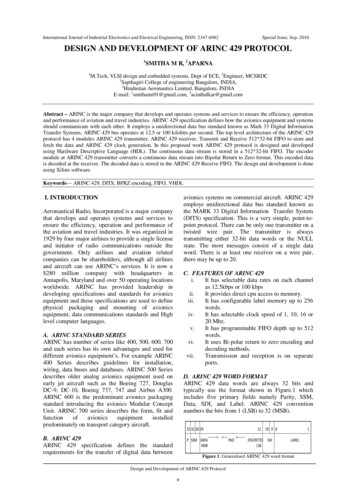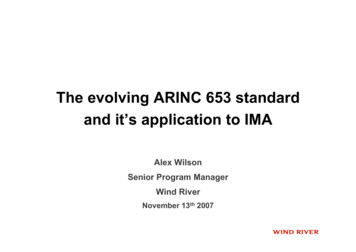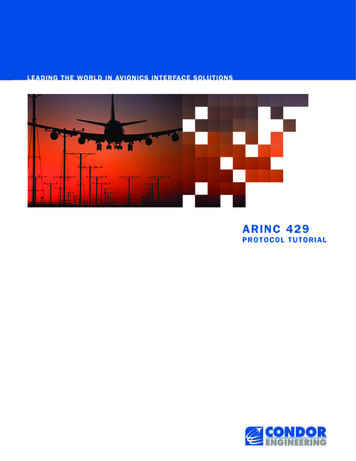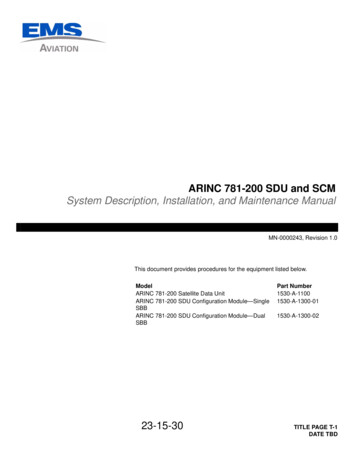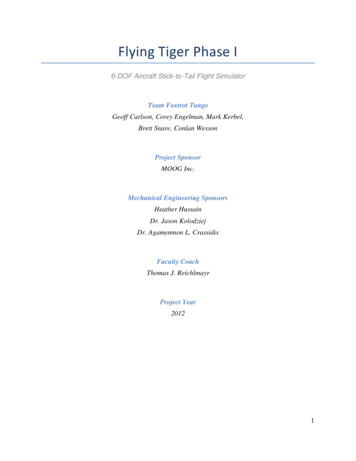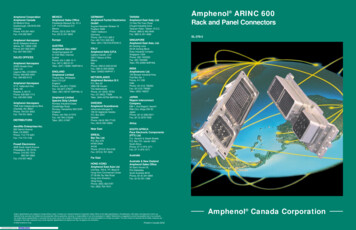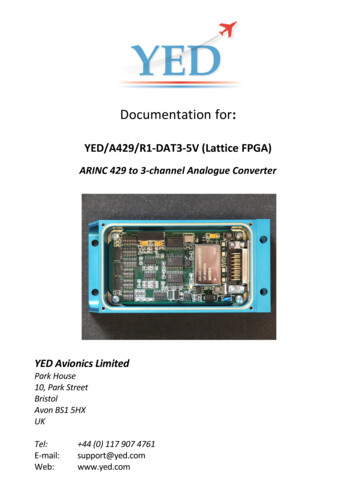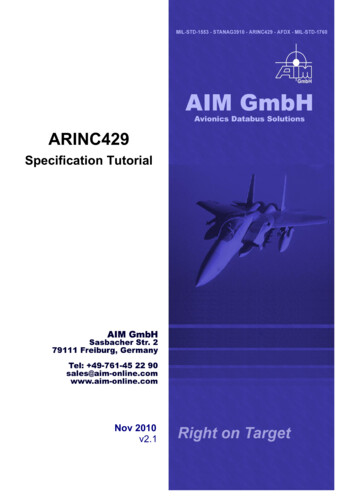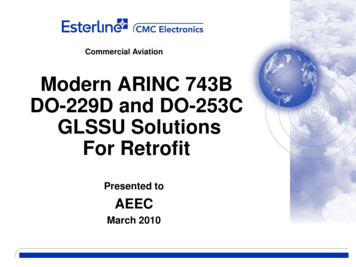
Transcription
Commercial AviationModern ARINC 743BDO-229D and DO-253CGLSSU SolutionsFor RetrofitPresented toAEECMarch 2010
The Classic Retrofit Challenge Financial:– Operating budget year financing– ROI payback: 1-2 years max– Investment usually comes from reduced fuel budget: save enoughon gas in 1-2 years to pay off the investment in the avionics. Retrofits make sense when the avionics bring new capabilitymeasurable in better fuel economy at a reasonable retrofit costto airframes with long lives ahead. Retrofit aircraft equipage assumptions:– GNSS with or without inertial navigation– Minimal or no FMS modifications– Retrofit solution must “bolt-on” solution, not a gut and re-equip2CMC Electronics Inc Confidential and Proprietary InformationSeptember 2007
What do these Terms have in Common?ADS-BDO-229DGBASSBASARINC 743BRNP0.1IntegrityLPV TSO-C145c Beta-3CAT-IGagan99.999% AvailabilityEGNOSGLSSA-AwareDO-253CTSO-C146 Delta-4Airbus A-350 LPV!Primary Means of Navigation n3CMC Electronics Inc Confidential and Proprietary InformationSeptember 2007
Some Answers: All are “added” features– Enabled through augmented GPS receivers & integrated with aircraft operation– Provide substantial new benefits to air transport operators– but which are not generally supportable by 1st gen GPS receivers, of which there arethousands in current airline service, even if updated as “SA-Aware” – Positioned to take advantage of the “Next Gen” Airspace The ARINC 743B Characteristic captures the current GPS L1 receiveraugmentations:– SBAS enabled navigation and LPV– GBAS GLS– All in one ARINC 743B GPS receiver ( VDB receiver). The GPS L1 signal remains to be fully exploited:it remains to exploit SBAS&LPV GBAS GLS in an all-in-one receiver as a totalnavigation and approach solution. The ARINC 743B Characteristic allows growth to an expanded GNSS receiverwith essentially the same aircraft interface.– Equipment impact: the GPS receiver & antenna will probably be replaced as a minimum.– Remark: an expanded GNSS may bring additional benefits to commercial aviation,but these need better definition.4CMC Electronics Inc Confidential and Proprietary InformationSeptember 2007
Focus on Augmented GPS: SBAS/GBAS Receivers Non-Augmented GPS receivers do not have the requiredintegrity-availability-continuity to support the transition to aperformance-based navigation infrastructure– Shift from ground-based to satellite-based services– Eventually navaids like VOR and NDB will be “divested”– NAS-wide services for enroute, terminal and approach, includingbackup for approach and landing, are all GNSS based With SBAS augmentation:– By far the most accurate, highest integrity navigation system thereis with Primary Means Navigation (not so with a SA-Aware only Rx)– Enhances RNAV, RNP navigation & RNP SAAAR (RNP0.1)– Meets ADS-B requirements (position integrity & velocity with FOM)especially in the terminal area– LPV, CAT-I equivalent available today With GBAS augmentation:– GLS CAT-I today, but no Federal Acquisition Program for LAAS– CAT-II/III in future, being worked, using GPS L1 only.5CMC Electronics Inc Confidential and Proprietary InformationSeptember 2007
Capability of an ARINC 743B Receiver Is self-contained and focuses only on GNSS navigation andapproach capability (does not drag around classical receiverssuch as VOR, ILS, etc ) as part of its characteristic. Accounts for DO-229D, SBAS Navigation and LPV Accounts for DO-253C, GBAS GLS Enables RNP0.1 (RNP SAAAR) & Primary Means of Navigation Address ADS-B position & velocity outputs, including ADS-Boperations in the Terminal Phase of Flight Address retrofit aircraft cost effectively Allows for growth to new GNSS and augmentations withoutsignificant impact to aircraft or systems.6CMC Electronics Inc Confidential and Proprietary InformationSeptember 2007
SBAS/GBAS ARINC 743B Receiver GBAS and SBAS combined in one receiver New approach connector is defined for Alternate Form FactorGLSSU receiver– Glide Slope and Localizer look-alike guidance, identical to ILSprovided on ILS look-alike bus– Provides DME look-alike, identical to DME provided on DME lookalike bus– Retain existing ILS, displays, FMS, and avionics in general– add “bolt-on” GPS/SBAS navigation & SBAS/GBAS approachsolution– Has built-in digital High Integrity Switch to intercept ILS and DMEbusses and replace with GLSSU derived LOC/GS and DTG– Rectilinear guidance also provided as required by GBAS MOPS forboth GBAS and SBAS approaches on GLS bus– Fresh 10 Hz navigation & approach data provided on GLS bus forflexibility to compute guidance on other equipment7CMC Electronics Inc Confidential and Proprietary InformationSeptember 2007
SBAS/GBAS Navigation Receiver Primary Means Navigation with SBAS– SBAS receiver uses SBAS differential GPS data, and integrity information to: ––––––Produce a more accurate navigation solutionProduce a better integrity (smaller HIL, HPL) and much better availabilityRNP0.1 Integrity 99.999% under SBAS coverageRNP0.3 Integrity 100% under SBAS coverageCoverage is entire SBAS satellite footprint (continental)SA-Aware when not under SBAS coverageCertification is TSO-C145c for navigation, TSO-C146c for approach guidance, may have bothIn general, C145c equipment performs as well as or outperforms C196 (SA-Aware) equipment. Better Local Area Navigation with GBAS– GBAS receiver uses GBAS differential GPS data and integrity information to: Produce a more accurate navigation solutionProduce a better integrity (smaller HIL, HPL) and much better availability– Coverage limited to 23 nmi operational radius defined by VDB link budget– LAAS TSO-C161a base a certification, one of: TSO-C129a, TSO-C145c, or TSO-C196 Impact of SBAS GBAS on Aircraft Navigation Interface (ARINC 743A):–––––No impact on navigation interface, no impact on standard ARINC 743 navigation connectorSame labels for position solution, same label for integrity informationOnly difference is that data is more accurate, better integrity availabilityImpact on ARINC 743: no impact, aircraft is presented with a better solutionOptional labels exist, if exercised, then there will be modifications, but not needed.8CMC Electronics Inc Confidential and Proprietary InformationSeptember 2007
SBAS/GBAS Approach Receiver DO-229D GPS/SBAS receiver classes– Defines a Beta and Delta class receiver (Gamma class not discussed) Beta class is a navigation receiver, does NOT provide Glide Slope or Localizerguidance, relies on some other equipment to do guidance (FMS?) Beta Class receiver interface is essentially unchanged for navigation, the standardconnector is the “navigation connector” with same navigation interface definitions. Delta class is an approach receiver, provides Glide Slope and Localizer guidance Delta Class receiver interface defines a new approach connector Delta class receiver can have its own FAS or it down-load the FAS from the FMS– Beta Delta class receiver can be combined as one receiver– Beta Delta class receiver can be a complete stand-alone navigation andapproach receiver Approach does not have to be driven by a FMS Navigation solution used by FMS as if GPS only DO-253C GBAS receiver– No equipment classes GPS or GPS/SBAS navigation outside range of GBAS ground station GBAS Differential navigation within range of ground station if that service isprovided by the GBAS ground station Approach guidance within range of ground stationCMC Electronics Inc Confidential and Proprietary InformationSeptember 20079
SBAS/GBAS Approach Receiver, How It’s Done The Guidance Solution– Must be ILS Look-Alike: Glide Slope and Localizer outputs– Must be DME Look-Alike: Distance to LTP/FTP– Delta Class receiver behaves exactly as an ILS receiver – aircraft systems see Delta Classreceiver as an ILS receiver – true ILS look-alike. Result: no aircraft systems need to bemodified– Ability to switch between ILS and GPS approach with built-in High Integrity Switch Impact on FMS and aircraft– In retrofits, maximize use of existing aircraft displays, autopilot without modifications. Thisis the key to low cost.– However, FMS must provide for: FMS procedures for GPS RNAV, guidance to FAF, “same as for ILS” FMS procedures for GPS RNAV missed approach, “same as for ILS”– FMS does not have to be modified to control GLSSU receiver, can be done with a separatecontrol head– FMS does not have to host the LPV database, GLSSU can host 2 cycles of the entire worldwide LPV database, CMC GLSSU: 12Mb/cycle, 2 cycles (total 24 Mb). Impact on Aircraft Approach Interface:– Provides Glide Slope and Localizer look-alike guidance, identical to ILS– Provides DME look-alike, identical to DME– Retain existing ILS, displays, add “bolt-on” GPS approach solution– Potential FMS impact to provide RNAV and Missed Approach Guidance10CMC Electronics Inc Confidential and Proprietary InformationSeptember 2007
SBAS/GBAS Approach Receiver, What It Delivers DO-229D– Defines a Beta and Delta class receiver Beta class is a navigation receiver, does NOT provide Glide Slope or Localizer guidance Delta class is an approach receiver, provides Glide Slope and Localizer guidance Delta class receiver can have its own FAS or have it down-loaded from the FMS– Beta Delta class receiver can be combined as one receiver– Coverage tends to be entire continental airspace– Beta Delta class receiver can be a complete stand-alone navigation and approachreceiver, fully independent of a FMS DO-253C– GBAS receiver uses GBAS differential GPS data and integrity information to: Produce a more accurate navigation solutionProduce a better integrity (smaller HIL, HPL) and much better availabilityprovides Glide Slope and Localizer guidanceCAT-I Approach capability, CAT-II/III TBD approval with GPS L1 signal.– Coverage limited to 23 nmi operational radius as defined by VDB link budget Impact on Aircraft Navigation Interface (ARINC 743):– None foreseen– Same labels for position solution, same label for integrity information– Only difference is that data is more accurate, better integrity availability– Impact on ARINC 743: no impact, aircraft is presented with a better solution.11CMC Electronics Inc Confidential and Proprietary InformationSeptember 2007
Practical Example of an ARINC 743B receiver retrofit GLSSU developed by CMC Electronics as an alternative to MMR– ARINC 743B Alternate Form Factor– Today: SBAS LPV– Tomorrow: SBAS LPV & GBAS GLS in one receiver: GLSSU External VDB receiver, same foot-print Example: classic B-757 Retrofit– No GPS– VOR/DME & INS navigation– ILS approach12CMC Electronics Inc Confidential and Proprietary InformationSeptember 2007
A Practical Example of an ARINC 743B SBAS/GBAS receiver GLSSU dual purpose:Antennaconnector– SBAS NavigationRNP0.1 performanceADS-B in terminal areaPrimary Mean NavSA Aware built-in– SBAS LPV GBAS GLS Complete GLSSU system:Standard ARINC 743Navigation Connector– Built-in High integrity switch forILS-GLS signal source selection– External VDB receiver for GBAS– Optional control head– Addition of guidance modeILS-GLS/LPV selector– Active antenna, TSO C-190,required for LPV or GLSPrecisionApproachConnectoroptional Control Headfor Stand-alonePrecision Approach13CMC Electronics Inc Confidential and Proprietary InformationSeptember 2007
CMA-5024 IntegriFlight GLSSU SBAS/LPV GPS Landing GLSSU in single unit– Certified (2008) to highest standardsTSO-C145c Beta-3 & TSO-C146c Delta-4 No “Waivers” of any sort Primary Means of Navigation Supports RNP0.1 certification Supports ADS-B requirements, NAC V 2 Built-In WAAS LPV FAS Database Built-in High Integrity Switch ILS/GLS switch– SA-Aware world-wide– ARINC 743A-4/5 & 743B compliant– Unmatched 40,000MTBF– Aircraft Personality Data (APD) provision toconfigure interface to specific airframe type.– Upgradable to LAAS, external VDB required– CAT-IIIb ready: All-in-view 24-ChannelNarrow Correlator technologyCMA-5024 GLSSUCMA-5025 Control Panel14CMC Electronics Inc Confidential and Proprietary InformationSeptember 2007
CMA-5025 IntegriFlight Control Panel - Overview TSO-C146c Delta-4 Smallest “standard” form factor– 2.25” X 2.5” X 4.5” Connects to GLSSU:– Controls and selects WAAS LPVICAO tuning range from(40000 to 99999)– Controls and selects LAAS GLSICAO tuning range from(20000 to 39999) 20,000 hour MTBF Left and Right CMA-5025 connect to Left and Right CMA-5024s GLSSUs crosstalk tuning at all times, all GLSSUs tuned to same approach Both CMA-5025s will display same active approach (GLSSUs will cross-talk thetuning among themselves and to the opposite control panel) Either side can select tuning, opposite control panel will display same selectedapproach, all GLSSUs will tune to same selected approach.15CMC Electronics Inc Confidential and Proprietary InformationSeptember 2007
CMA-5010 IntegriFlight VDB Receiver - Overview Dedicated VBD Receiver(planned)– RTCA/DO-253C– ARINC 755 I/O compliant 3 Connectors:– Data and Power ConnectorConnected only to GLSSU– 2 RF Connectors: (In and Out)Configurable RF ILS/VDB switch,3dB power split or active RF Controlled only by GLSSU andILS/GLS Approach Select Switch 40,000 hour MTBF target An “Add-Below” to existing GLSSUCMA-5010VDB ReceiverRepresentative Unit– Identical “footprint” to GLSSU– Slim deck height, approx 1 inch16CMC Electronics Inc Confidential and Proprietary InformationSeptember 2007
CMA-5010 IntegriFlight VDB Receiver - OverviewCMA-5024GLSSUCMA-5010VDB ReceiverRepresentative UnitMountingBolts17CMC Electronics Inc Confidential and Proprietary InformationSeptember 2007
ILS / DME Top Level DiagramRadio ManagementUnitDMECockpit Avionicsand DisplaysAutopilotSource SelectILSReceiverAutopilotFlight Director18CMC Electronics Inc Confidential and Proprietary InformationSeptember 2007
ILS/DME GLS Approach Top Level DiagramGLS ControlHeadGLSReceiverVDBReceiverRadio ManagementUnitDMEAutopilot GLS/ILSSource SelectILSReceiverHigh Integrity SwitchCockpit Avionicsand DisplaysAutopilotFlight Director19CMC Electronics Inc Confidential and Proprietary InformationSeptember 2007
Architecture in a classic 757 NO GPSFDR RFDR LFMS RFMS LILSILSILSNav DataNav Receiver LRFRFLOCANTLOC/GSILSReceiver LDMELLOC/GSDTGRFRFLOCANTILSReceiver LDMERExisting Auto Pilot Instruments Without ModificationILS and ILS Look-Alike (GLS LOC and GS) Signals20CMC Electronics Inc Confidential and Proprietary InformationSeptember 2007
Architecture in a classic 757 SBAS (SA-Aware)FDR RFDR LFMS RFMS LILSILSILSNav DataNav DataGLSSU receives bothGPS and SBAS signalsProvides best solutionGLSSU Receiver LGLSSU RGPSRFRFLOCANTLOC/GSILSReceiver LDMELLOC/GSDTGRFRFLOCANTILSReceiver LDMERExisting Auto Pilot Instruments Without ModificationILS and ILS Look-Alike (GLS LOC and GS) Signals21CMC Electronics Inc Confidential and Proprietary InformationSeptember 2007
Architecture in a classic 757 SBAS LPVFMS RFMS LControl Panel LGLSSU Bus is across-talk bus:All tuning data sharedAll GLSSUs tuned tosame approachFDR RFDR LGLS/ILSGLS/ILSGLS/ILSControl Panel RGLSSU BUSNav DataNav DataGLSSU RGLSSU CGLSSU LGPSGPSGPSGLS TuningGLS TuningGLS/ILS Select LLCRLCRGLS/ILS Select eiver LRFRFLOCANTLOC/GSILSReceiver LDMELLOCANTCRLCRLOC/GSDTGRFRFLILSReceiver LDMERExisting Auto Pilot Instruments Without ModificationILS and ILS Look-Alike (GLS LOC and GS) Signals22CMC Electronics Inc Confidential and Proprietary InformationSeptember 2007
Architecture in a classic 757 SBAS LPV GBAS GLSFMS RFMS LControl Panel LGLSSU Bus is across-talk bus:All tuning data sharedAll GLSSUs tuned tosame approachFDR RFDR LGLS/ILSGLS/ILSGLS/ILSControl Panel RGLSSU BUSNav DataNav DataGLSSU RGLSSU CGLSSU LGPSGPSGPSGLS TuningGLS TuningGLS/ILS Select LLCRLCRLOC/GSDTGLOC/GSDTGLOC/GSVDB RF SW LRFRFLOCANTVDB RF SW CVDB RF SW CLOC/GSDTGILSReceiver LRFRFLOCANTGLS/ILS Select RLOC/GSILSReceiver LDMELLOCANTCRLCRLOC/GSDTGRFRFLILSReceiver LDMERExisting Auto Pilot Instruments Without ModificationILS and ILS Look-Alike (GLS LOC and GS) Signals23CMC Electronics Inc Confidential and Proprietary InformationSeptember 2007
Concluding Remarks SBAS and GBAS in one receiver as a simple retrofit solution for classicaircraft is possible. GLSSU with SBAS available today GLSSU with GBAS coming soon. To consider future standards:– Radio box with classical radios (ILS, VOR, etc) in one box, but NO GPS– Separate GNSS box GPS, SBAS, GLS today Coming: GPS L1 & L5, Galileo, and still newer things on drawing boards The GNSS receiver will undergo changes for decades to come. Does itmake sense to integrate it with ILS, VOR, etc ?24CMC Electronics Inc Confidential and Proprietary InformationSeptember 2007
25CMC Electronics Inc Confidential and Proprietary InformationSeptember 2007
-All in one ARINC 743B GPS receiver ( VDB receiver). The GPS L1 signal remains to be fully exploited: it remains to exploit SBAS&LPV GBAS GLS in an all-in-one receiver as a total navigation and approach solution. The ARINC 743B Characteristic allows growth to an expanded GNSS receiver with essentially the same aircraft interface.
